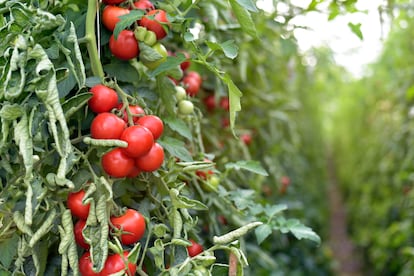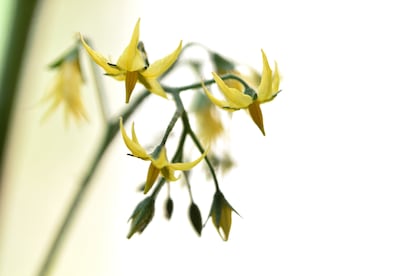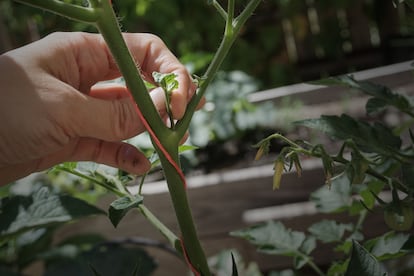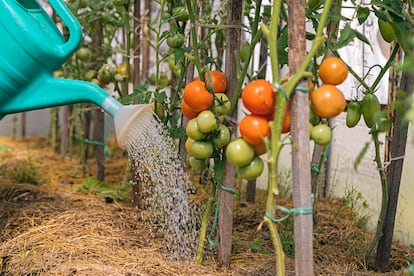How, when and why tomato plants should be pruned
To prune or not to prune is the dilemma that divides horticulture hobbyists when it comes to tomatoes. The variety of the plant contains the answer, but there are some general keys to learn something extra about the most popular crop among beginners

Summer is tomato season. The fruit of this plant, from the Solanaceae family, benefits from the long, sunny days of this season. The multifarious immensity of tomato varieties and its omnipresence in summer cooking recipes make it one of the favorite crops for those who take up horticulture as a hobby. But tomato is not an easy crop. It is a fairly sensitive plant. To thrive, it needs a generous amount of substrate, specific water, fertilizer and sunlight needs, and its cultivation is exposed to a variety of problems such as fungi, diseases and pests. Factors that must be taken into consideration before starting to cultivate it. Later on, in addition, a new dilemma will arise: that of how to prune the plant to contribute to the development of its fruits.
The first thing that may surprise an upstart tomato grower is that not only is there no solid consensus on the issue of pruning the plant, but directly, often when searching for information, the word “controversial” appears more at once. There are conflicting positions among horticulture educators regarding the issue of tomato pruning. Toni Jardón, responsible for the blog La Huertina de Toni, tries to look beyond this disagreement of criteria from his personal experience in his orchard in Bolgues (Asturias). “I think the controversy comes from the different ways and currents of cultivation,” he explained to EL PAÍS. “A more natural or close to nature cultivation makes us think that there would not be a person behind taking away from the tomato plant what we consider it does not need to develop.” However, he, who does not admit to being an enemy of picking up pruning shears, points to the tomato variety as the key to knowing the pruning needs of the plant.
Varieties of determinate growth
In general, reducing the leafiness of the leaves of a tomato plant is a measure that is recommended to favor the production of fruits. But, as Jardón notes, there are exceptions: “A tomato with a determined growth, that is, one that grows to a maximum height, is not usually pruned. The plant is not going to develop more than that size and, therefore, we are interested in getting as much flowering as possible”, he explains.
Ester Casanovas, author of titles such as Hortelanos de ciudad (Ediciones invisibles, 2014) and the disseminator behind Picarona Blog, is a specialist in getting the most out of a container garden, which suits many beginners. Determinate size tomato plants, as Casanovas points out, are perfect for adapting to the limitation of substrate typical of a pot (15-20 litres). These plants do not grow very large, and therefore pruning them, he warns, could mean giving up part of their production.

As Casanovas points out, some of these varieties, such as bonsai and hanging ones, "tend to bear all the fruits at once," he clarifies in a post on his Instagram profile, warning that it could be difficult to identify an axillary shoot from one that doesn't. it is: “They are more prolific if we leave them to their ball”.
The advice given by gardening youtuber Kevin Espiritu to the two and a half million subscribers to his channel, Epic Gardening, is to know the way in which the tomato plant grows and is structured before pruning. Those who have cultivated them know that they develop alternating branches of leaves and branches of flowers that, if everything goes according to the objectives of the gardener, will become fruit. Like a ladder of leaves and flowers. Those leaf steps are also necessary for the growth and productivity pursued, since it is through the leaves that the plant manages to carry out photosynthesis. What part can be removed then? The focus is placed on the so-called “pacifiers”, a name that already reveals a popularity that is not highly valued.
What are suckers (or axillary buds) and how to distinguish them
"The suckers are shoots from which the plant will develop new stems, with new leaves and fruits," explains Toni Jardón. These axillary shoots (because they appear in what might appear to be the axil between the stem and the leaves) can be removed using your fingers when they are still very small. "It is the easiest and the least harmful, because they come out whole and the wound that is done to the plant is less." A precaution that can prevent future problems for the plant.

The sucker sprouts between the main stem of the tomato plant and one of the leaf layers, forming an angle of 45 degrees with respect to both. If they are not pruned, the plant will develop a new branch from this bud, which in turn will have new leaf and flower nodes. Therefore, you will need to spread your current resources with this new branch as well, hence this is the biggest consideration when deciding to remove it.
Reasons to prune (but never excessively)
For Toni Jardón, ventilation is a quality that must be preserved when growing tomatoes, and it is something that is achieved thanks to periodic pruning. “Tomato is a crop that is very sensitive to humidity. Quickly, fungi appear that can leave us without a crop. A very crowded plant with little ventilation is more prone to fungi developing and spreading," says the popularizer based in Asturias, who highlights other benefits of pruning such as obtaining larger fruits and the possibility of placing crops more close to each other.
When in doubt, it is common to start advising the pruning of those leaves that are below the first flower node. Some leaves that due to their proximity to the ground could be exposed to more harmful agents and that are not necessary for the development of the plant. Other leaf nodes that should be removed are those affected by fungi and leafminer worms (which create grooves of a different shade on the leaves as they feed), thus preventing the attack from spreading to the rest of the plants. .
Excessive pruning also leads to problems, as recognized by the horticulture popularizer: "Plants need the leaves to receive the sun and feed themselves." So it's important to make sure you leave enough leaves, which also protect the fruits from excessive sunlight impact.

It is common to find the advice, as a precaution, to prune before watering, and not the other way around. The reason is that the water, and what it could take with it, does not penetrate into the open spaces on the surface of the stem after pruning. However, Jardón prefers to stick to a previous precaution to avoid diseases, which consists of watering without wetting the plant. In addition, he advises to disinfect the scissors well when changing plants "to avoid spreading spores from one to another."
Unexpected uses of suckers: origin of new plants and natural insecticide
Suckers are not entirely undesirable sprouts when it comes to growing tomatoes. For Jardón, it is the best way to reproduce tomato plants and obtain a clone. Something he advises to do in case the first plant dies. “Normally, we plant the suckers around the mother plant,” he explains. Although he points out that these take root well, regardless of their size, he does recommend waiting until they have reached 10 or 15 centimeters: "Its roots can develop both by planting it in a pot or in a glass of water."
From the pruning of tomato plants other unforeseen benefits can arise, as an effective remedy against some garden pests, such as the cabbage butterfly, caterpillars, fleas and aphids. In a video hosted on his channel, Jardón explains how to make an insecticide using suckers and some branches that have been pruned (but healthy, that have not been infected by fungi). The result of straining and placing in a sprayer the combination of these chopped branches with plenty of water (one liter for every 100 grams of branches), removed once a day for six days in the shade, has shown for the gardener to be effective in the prevention and elimination of this type of pests in their crops. “Solanaceous plants such as tomatoes contain compounds called alkaloids in their leaves that are toxic to certain pests,” he details. Because the lessons learned from a small amateur garden multiply with experience.
Sign up for our weekly newsletter to get more English-language news coverage from EL PAÍS USA Edition









































